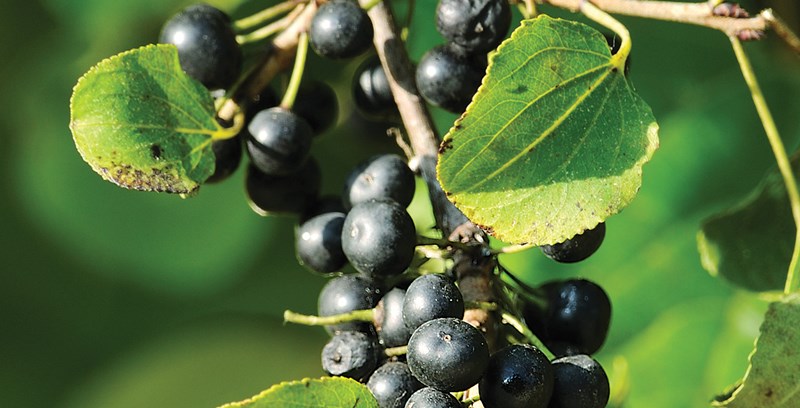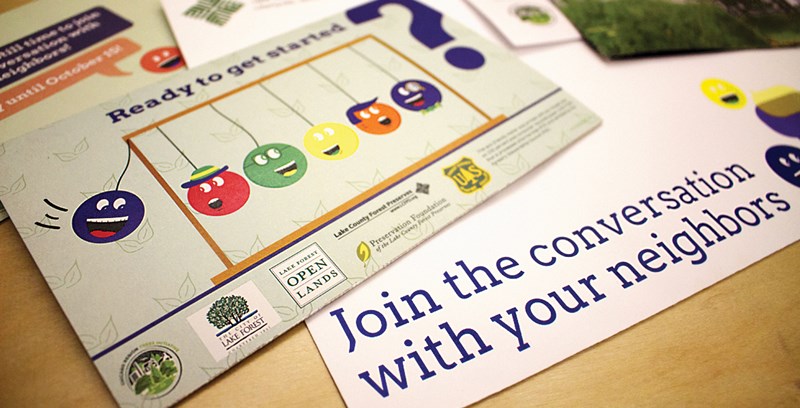Science in the Preserves
We are serious about our goal to eradicate the non-native invasive species, buckthorn, from our forest preserves and beyond. In 2015, we convened several regional organizations to discuss ideas for controlling buckthorn. This conversation was organized to launch a pilot project to improve landscapes within the vicinity of Middlefork Savanna.


Around that same time, we forged a partnership with social scientists at the U.S. Forest Service (USFS). Eager to discuss applicable methods for behavioral change and conservation psychology, we teamed up with researchers at the USFS to determine people’s perceptions of the trees and aesthetics in the buckthorn pilot area.
We distributed a homeowner survey to research the best ways to eradicate buckthorn and support native landscapes. All residents within the pilot project area received the same questionnaire. The survey consisted of multiple choice and open-ended questions, following a format based on the Theory of Planned Behavior, a well-accepted way of predicting people’s intentions to act on a given issue. These important predictors have been successfully used in many studies of land management. Related questions about people’s activities and values regarding yards, landscaping, and the environment will help us better understand their willingness to take action.
Over six months, we compiled and analyzed responses. Participation and responses to this survey was used to enhance outreach efforts, focus restoration activities, and inform similar projects throughout the region. Homeowners who participated in the survey received a report of results and the first invitations to join us in this effort to build a more resilient future for Lake County.
Buckthorn Homeowner Survey Results
Several homeowners have already volunteered to join the movement to eradicate buckthorn. Whether they have removed buckthorn from their yard or are simply considering it, every resident who participates will benefit the community. Below is a full copy of the results that survey participants received from us in July 2018. Flip through the report below or read it here to learn more.
Additional Resources
The links below provide further information about identifying local species, eradicating invasive species, living with wildlife, and other natural resource topics.
All About Birds »
The Cornell Lab of Ornithology’s online guide to North American birds, bird songs, birding basics and more.
Animal Diversity Web »
An online database and encyclopedia of animal natural history, built through contributions from students and photographers.
Go Botany »
Simple identification key to thousands of New England plants. Many of the species have ranges that extend to include Lake County, Illinois.
Illinois Butterfly Monitoring Network »
Engages citizen scientists in the process of collecting quantitative data on butterfly populations. Find common butterfly photo galleries and learn how join the effort.
Illinois Wildflowers »
Detailed identification information, habitat type, faunal associations and range maps of wildflowers found in Illinois.
LCFP Mobile App (iPhone) »
LCFP Mobile App (Android) »
Stay up-to-the-minute with what's happening in your forest preserves on your smartphone. Available for free in the Android Market or Apple App Store. Search for "Lake County Forest Preserves."
Leaf Snap »
An electronic field guide being developed by Columbia University, the University of Maryland and the Smithsonian Institution. Currently includes trees of the northeastern United States.
Odonata Information Network »
Images, maps and sightings of North American dragonflies and damselflies. Allows you to search species lists by state.
Rapid Color Guides »
Field guides created by the Field Museum fill a gap in the published material available to identify live species. Search the inventory of Chicago region field guides, including asters, butterflies, dragonflies, spring flora and more.
Asian Carp »
A site established to coordinate the control and management of Asian carps in the United States.
Emerald Ash Borer »
Part of a multinational effort in the northeastern United States and eastern Canada to provide the latest information about emerald ash borer.
Emerald Ash Borer, Illinois Department of Agriculture »
Current quarantine restrictions, firewood regulations and community plans within Illinois.
Emerald Ash Borer, United States Department of Agriculture »
“Stop the Beetle” campaign provides information on signs, symptoms and identification of the emerald ash borer.
Illinois-Indiana Sea Grant »
Research, education and outreach about aquaculture, aquatic invasive species and health of the Great Lakes, empowering Lake Michigan communities to secure a healthy environment and economy.
Midwest Invasive Plant Network »
We are partners in this diverse group with a mission to reduce the impact of invasive plant species in the Midwest. Learn more about identification, prevention, and control of invasive species, as well as native alternatives for invasive ornamental plants.
New Invaders Watch Program »
We are partners in this early detection and rapid response network of organizations dedicated to controlling new invasive species. Learn more about identification of species and how to report new invaders.
Northeastern Illinois Invasive Plant Partnership (NIIPP) »
More than 500 species of plants have been introduced into the Chicago region in the past 200 years. Species that become invasive create a lot of trouble.In 2010, Chicago Wilderness members launched this partnership to coordinate efforts to manage invasive plants species across the region.
Plant Heroes »
The materials on this site are free and great for any community group seeking educational tools and resources for youth and how they can combat invasive plant species.
Ticks, Lake County Health Department »
The Health Department offers visual identification tips, a fact sheet on tick prevention and a brief video on how to avoid ticks and what to do if you find a tick on yourself or your pet.
West Nile Virus, Centers for Disease Control and Prevention »
West Nile virus statistics, maps, prevention and other frequently asked questions.
West Nile Virus, Illinois Department of Public Health »
Prevention and control of West Nile virus through the use of insect repellents.
Bring More Birds to Your Home »
Explore Audubon’s database of native plants best adapted to attract birds to your backyard.
Conservation@Home »
Conserve Lake County makes it easy for landowners to save time and money on landscaping, while creating a healthy and peaceful sanctuary in your own backyard.
Create a Certified Wildlife Habitat® in Your Backyard »
By providing food, water, cover and a place for wildlife to raise their young you not only help wildlife, but you also qualify to become an official Certified Wildlife Habitat® with the National Wildlife Federation.
Home Science: Backyard Conservation »
Environmental conservation is an important issue in today’s world, and there are lots of ways to help in your own backyard.
Morton Arboretum Community Trees Program »
Helps communities, public and private landowners, land managers, tree professionals, and groups interested in trees effectively manage and care for our urban and community forests.
Feral Cats »
Chicago Wilderness position statement on feral and unattended domestic cats outdoors.
Kitty Cams »
National Geographic and University of Georgia collaborated on this research project, investigating the activities of urban free-roaming cats with goals for wildlife conservation and improving the health and well-being of pet cats.
Urban Coyote Ecology and Management »
The Cook County, Illinois Coyote Project is a comprehensive study of coyotes in the Chicago metropolitan areas.